Azomite, red lava rock, manure, bone meal, worm castings
Here's my verdict:
Azomite: yes, perky leaves in high heat, deeper bloom colors.
Red lava rock: yes, continuous supply of potassium & continuous blooming on Radio Times rose.
Bone meal: no, cannot be utilized when the pH is over 7, such as my alkaline clay. Apply on top: burns roots. Apply in the planting hole: useless.
Worm Castings: haven't tried yet, but found an excellent website. See excerpt from below:
http://www.worldofworms.com/chemical-side-of-worm-casting/
" The following is taken from Virginia Tech publications on nutrient-deficiencies in hydroponic plants:
Nitrogen – Entire plant is light green in color; lower leaves are yellow; growth is stunted.
Phosphorous – Entire plant is bluish-green, often developing a red or purplish cast; lower leaves may be yellow, drying to a greenish-brown to black color; growth may be stunted.
Potassium – Leaves have a papery appearance; dead areas along the edges of the leaves; growth is stunted.
Magnesium – Lower leaves turn yellow along the tips and margin
and between the veins; the lower leaves wilt.
Calcium – Young stems and new leaves die.
Zinc – Leaf tissue between the veins is lighter in color; yellowed; papery in appearance.
Iron – Leaf tissue appears yellow, while the veins remain green.
Copper – Leaf edges appear dark green or blue; leaf edges curl upward; young leaves permanently wilt.
Sulfur – Young leaves turn pale green, while the older leaves
remain green; plant is stunted and spindly.
Manganese – Growth is stunted; lower leaves have a checkered pattern of yellow and green.
Molybdenum – Leaves are stunted, pale green, and malformed.
Boron – Young leaves are scorched at tips and margins.
Researchers potted plants starting in different ratios of cast to soil, and found the plants with the optimum growth were planted in a cast:soil ratio of 1:4, or 75% soil. However they have shown that even 10% of wormcast shows significant difference in plant growth.
Once the percentage of wormcast is over 40%, plant growth performance is stunted and may even appear worse off than having no wormcast at all. So your use of 50% wormcast is definitely too much! Kenneth
c/o WormMan Newsletter http://wormman.org/?p=162
** From Straw: below is a bouquet which shows the deepening effect of Azomite (over 60+ trace elements). Blooms are cut at 88 degree, hot & dry weather. CPM (orange) was previously light beige, I was so disgusted so I tried Azomite. Radio Times was light pink, now darker pink & smells better. Folks reported Azomite enhanced the flavor of vegetables. Evelyn doesn't count, since it got Azomite plus horse manure, the deepening could be from both. CPM (orange) and Radio Times (pink) get Azomite only:
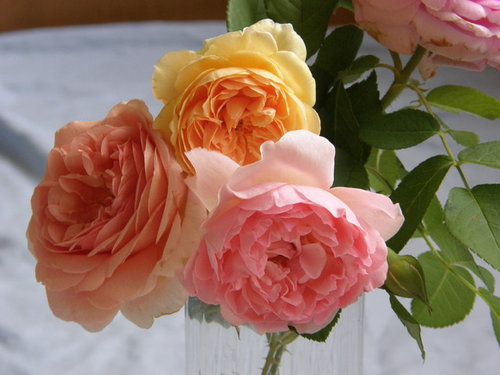
Comments (36)
strawchicago z5
Original Author8 years agolast modified: 8 years agoHere's a before picture without Azomite. Wise Portia was mulched with red lava rock and cocoa mulch. Lots of blooms, but plant is droopy. Picture is taken in the morning, after overnight-rain which filled up my 3-rain-barrels, note droopy leaves from calcium being leached out with rain & high heat above 80 degree:

A few days later, in hot weather at 88 degree, I gave it 1 Tbs. Azomite per gallon of water. Note how leaves are perked up:

I also gave Azomite to Pat Austin to see if that would increase vase-life. I rarely pick Pat for the vase, since it shatters. This is Pat bloom in its 3rd day, picked as a bud. Note the deepened color & perky leaf:

Finally close-up bouquet of roses fertilized with Azomite: longer vase life, deeper colors. It dissolves well in water, so the result is immediate. Picture taken today, August 1, in hot weather above 80 degree.
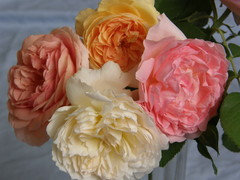
strawchicago z5
Original Author8 years agolast modified: 8 years agoWhen I googled pictures of Azomite on-line, I found the below picture:
Also an Australia website posted how Azomite increased fruits on a tree. Google "picture of Azomite" and you'll see. I tested that on Crown Princess Magareta rose. The last time I gave it chicken manure was early spring. It was a stand-still after the 1st flush, didn't produce any growth. I gave it azomite recently, and it shot up, throwing out 4 feet canes. No fertilizer on Crown P. M. except early spring. I also pruned CPM drastically after its 1st flush. Picture below is take August 4, about 10 days after Azomite. Azomite works faster than any nitrogen source, be it alfalfa meal or blood meal. I won't ever need to get horse manure to deepen my blooms' color either.

Related Discussions
HAVE: Update: I still have tomato seeds
Q
Comments (7)I have these to trade: 20 seeds each. Spinach Wyatt-Quarles broccoli Wyatt-Quarles purple top turnips Wyatt-Quarles in exchange for your items: 2. Green Zebra (striped) (1 packs) H 2012 4. Amur Tiger (striped) Limited Availability (1 packs) H 2013 6. African Brown Limited Availability (1 packs) H 2013...See MoreHAVE: Tomatoes, Arugula, Endive, Cantalope, kale
Q
Comments (3)Hi there! I'm new so I don't have many seeds but I am willing to offer the ones that I do have! I have: Mammoth sunflower seeds Regular sunflower seeds Watermelon Seeds Pumpkin Seeds For some Hale's Best Cantalope Seeds....See MoreVolcanic rock, any nutrients?
Q
Comments (52)Here are a couple of links to the composition of red pumice, aka scoria. https://www.researchgate.net/figure/Chemical-composition-of-scoria-samples-Scoria_tbl2_236147186 https://www.researchgate.net/figure/Elemental-composition-and-oxide-content-of-red-scoria-and-pumice_tbl1_319048806 Neither of these really focuses on trace elements, so there isn't a complete inventory of what we would consider plant-relevant elements. But in general, even the ones in higher concentrations are less than 1% (some even less than 0.1% according to the second link). What I get out of this is that a dusting of this stuff is not going to do anything that an occasional amending with compost can't do....See MoreEffects of fertilizers on bloom color and health of plants
Q
Comments (32)ziyouzizai: Sorry for the belated response, have been busy killing japanese beetles and cutting blooms for the vase. It was in 2014 that I tested Milogranite in pots, and the flowering WAS NOT as good as MG-soluble for roses NPK 20-20-20. Milogranite practically has zero potassium. Fantastic idea to soak red-lava-rocks in ACIDIC rain water, I tested it for the past 3 years and that works really well. Since pH of red-lava-rock is high at 8.2, one needs an acidic agent, like rain-water at pH 4.5. If rain-water is not available, I put gypsum (19% sulfur) and vinegar in a bottle with red-lava-rock, along with my pH 9.1 tap-water (very alkaline). That's cheaper than buying sulfate of potash NPK 0-0-50, works well, but doesn't have the iron & trace elements like red-lava-rock. Also if your roses are grafted on Dr.Huey, they flower tons in the 1st year, but will be stingy in the following years, UNLESS THEY GROW THEIR OWN ROOT. But even if they grow their own root (on top of Dr.Huey), they can't bloom as well as the ones bought as own-roots....See Morestrawchicago z5
Original Author8 years agolast modified: 8 years agoBelow is a bouquet with my 1st bloom of Bronze Star rose (orange). I bought that end of June from Roses Unlimited for $10 per gallon, below picture was taken August 2. Pink bloom is Sonia Rykiel. Bronze Star was fertilized with Azomite, nothing else, its 1st bloom is very large:

strawchicago z5
Original Author8 years agolast modified: 8 years agoThis is a test to see if the quality of bloom of W.S. 2000 rose can be good with just minerals: red-lava-rock, Azomite, and pea gravel. Yes, I actually like the bloom better than horse manure: much bigger, more buds too. I like the earth's minerals more than manure: less salt, no antibiotics, and no de-worming medications. I never burn roses with minerals, but I burnt plenty of roses with manure: chicken, cow. and horse manure all have salt. Picture of William Shakespeare 2000 rose taken today, August 4 in hot & dry weather:
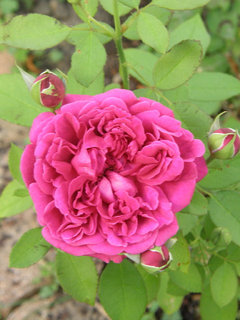
U of Colorado extension cautioned about NOT using manure in high-salt soil. Cay has higher-salt than loamy and sandy soil ... clay doesn't drain well and retains salt more. Here's an excerpt from below link:
http://www.ext.colostate.edu/mg/gardennotes/242.html
"Salt content may be high in fresh manure and decreases with exposure to rains and irrigation as salts are leached out. Continual and/or heavy applications of manure can lead to a salt build-up.
To avoid salt problems associated with the use of manure or compost made with manure, limit applications to one inch per year (when cultivated six to eight inches deep) and thoroughly cultivate the manure or compost into the soil. Have a soil test for salt content before adding large amounts.
Manure with a salt content greater than 10 dS/m (10 mmhos/cm) is questionable. Avoid use of manure on soils that are already high in salts (above 3 dS/m (3 mmhos/cm)."
strawchicago z5
Original Author8 years agolast modified: 8 years agoThank you, Prairie_north for a great question which helps a lot. I have heavy clay. The heavier the clay, the more it retains salt. A few sites on testing for salt: use electrodes to test for EC (electrical conductivity) .. that's done through a soil-test.
An easier, and cheaper way is to test seeds which are MOST SENSITIVE to salt, such as flax, corn, strawberry. The below link lists which ones are most sensitive to salt, the lower the EC values, the more sensitive ... such as flax and corn, both at 1.7, compared to more salt-tolerant crop with higher EC values: guar, barley, rapeseed (canola), rye. Scroll all the way down, and you see the tabulated data for salt-tolerance:
http://www.fao.org/docrep/005/y4263e/y4263e0e.htm
Whole flax seeds are cheap, same with whole-corn kernels ... just put a few of those seeds in the soil you want to test. If they sprout, then the salt is low. If they don't sprout, then the salt is high. I used cracked corn (with some whole kernels) to break up clay. The place with the most chicken-manure (10 applications over the past years) .. corn don't even sprout. But the place on the hill, no plant was grown, only decomposed grass ... corn was sprouting tons. I recently switched potting soil from Schultz to Sta-Green (Lowe's), since I saw tiny plants sprouting inside Sta-Green ... that's a good indication of low-salt & high-nutrients.
Tap water can be high in salt. My sister in Southern CA has high blood pressure, even when she's on a low-salt diet. A friend was softening his hard-water with salt, and the Dr. told him to quit that, thanks to rising blood pressure. Calcium, as in gypsum (8% salt index), or dolomitic lime (0.8%), or lime (4.7%), even Azomite (calcium chloride) all have calcium, and calcium helps to de-salt saline soil.
See below link for the salt-index of fertilizer, manures is VERY HIGH in salt, up to 20 to 30% percent. That's why I'm testing lower-salt organics: cracked corn & alfalfa hay for nitrogen, red-lava-rock for potassium, and dolomitic lime for calcium. For phosphorus, low-salt organics are: rice bran, wheat, oatmeal, shrimp shells, cantaloupe rinds, potato peels.
http://www.algreatlakes.com/PDF/factsheets/ALGLFS15_Fertilizer_Salt_Index.PDF
For heat tolerance and strong stems, I would use gypsum (dry & hot weather), or dolomitic lime (rainy weather) .. they work just as well as Azomite, but cheaper. I use Azomite for VERY DEPLETED soil, where gypsum doesn't work. There's a spot where I dug up a large evergreen tree. I put cracked corn & gypsum in the planting hole, then planted La Rein rose. It sat there doing nothing, no amount of nitrogen fertilizer helped (blood meal, alfalfa pellets). Then I gate it Azomite: it finally sprout new leaves & bud. Azomite supplied the missing trace-elements in a very depleted soil. The drawback of Azomite is calcium-chloride, high in salt.
For saltier & fertile clay-spots, previously fertilized with manure. I would use dolomitic lime, lowest in salt-index at 0.8, to de-salt that area, and to help plants to cope with heat, plus perkier leaves & stronger stem. It works just as well as Azomite, and much less salt.
prairie_northrose (3b north of Calgary AB, Canada)
8 years agoThank you for the information and excellent resources straw. I did not realize Azomite is high in salt. It makes sense that clay soil holds onto salt.
jim1961 / Central Pennsylvania / Zone 6
8 years agoLooks like Azomite is working well for you Straw! Great pics!
strawchicago z5 thanked jim1961 / Central Pennsylvania / Zone 6strawchicago z5
Original Author8 years agolast modified: 8 years agoI grow roses for the vase. One time I put calcium citrate tablet in the vase, and that helped petals to be firm & longer-vase life. Azomite is high in calcium, so the calcium offsets the salt-content of calcium chloride. Azomite helps leaves to be perky & firmer petals. I tested both in hot & dry weather above 80 degree: horse manure vs. Azomite, and I would take Azomite over horse manure. Azomite, used a soluble helped Wise Portia rose to be perky in the heat, but horse manure, as solids, burnt many of my roses in hot & dry weather.
The health of the leaves depend on if there's enough minerals in the soil. I look over pictures of Msdorkgirl's roses in pots: super-healthy thick leaves .. she uses Marine Cusine NPK 10-7-7 ... that has many minerals, plus trace elements.
I have 2 vases of cut-roses: One with rain water, pH 5.6, zero minerals. The other with hard-well tap water, pH 8.6, high in calcium. The leaves of the cut-roses in my tap water remain firm & healthy for many days. But the leaves in the rain-water vase ... they broke out in blackspots like Pink Peace, or else the "rain-holes" get larger, and the leaves shrank in size, or they wilt.
My neighbor has 2 types of landscape roses at the low & flooded area of her garden. She put sand at the bottom of Knock-outs' holes, that didn't help, they broke out in black spots, from sitting in the rain-water. She put pea-gravel, rich in minerals, at the bottom of Drift-roses, and they are healthy & vigorous. When it rains a lot, the roots are sitting on top of pea-gravel, which re-mineralizes them, so roses' leaves don't get holes & stay healthy. That's what I will do with all future holes that I dig: throw out bottom sticky clay, and put a thin layer of pea-gravel for better drainage & re-mineralization.
I keep one bad Yves-seedling just to do experiments. That one is a wimp & prone to black spots. Last year it became healthy with alfalfa hay on top as a buffer. This year I tested pea-gravel as buffer on top. That neutralized acidic rain well, plus more blooms on Yves-seedling. The pea gravel I use have variety of colors, more trace elements & nutrients. I put alfalfa hay ON TOP of pea gravel to shade them, so they don't heat up under hot sun. Below is a pic. of the pea gravel I used as a buffer on top, the smaller, the better:

- strawchicago z5 thanked jim1961 / Central Pennsylvania / Zone 6
msdorkgirl
8 years agoLava Rock on top of soil in potted plant:
Pink Peace own-root plant is struggling. I will remove the lava rock, prune some, and then put wood bark chips to see if it revives. This rose actually gets burnt very easy compared to the others that show wilt first.
It could also be the spot it's in, but at this point I have no real room to put him anywhere else.
OTHER ROSES STRUGGLINGTwo other roses are struggling, bought from the Direct Gardening website. Paul Neyron (no blooms, lanky growth), and the mystery pink (blooms, but leaf edges get burnt easy).
So Jim, I'll show you my black thumb when I post pictures later today! :)strawchicago z5
Original Author8 years agolast modified: 8 years agoHi Msgirl: thank you for the report on Pink Peace. Red-lava-rock on top helps with blooming in constant rain (rain leaches out potassium & calcium) ... but it backfired: too much potassium drives down calcium, and calcium is important for heat-tolerance & firmness. I scraped off the excess red-lava to put pea-gravel, which has a variety of colors & stones, more balanced nutrients.
I learn my lesson to keep nutrients balance: equal ratio of potassium & nitrogen & calcium & trace elements, which means BOTH red-lava-rock and dolomitic lime (or pea gravel), plus alfalfa hay for nitrogen. That's for acidic rain.
In hot weather & alkaline tap water, I had success using BOTH sulfate of potash and gypsum (calcium sulfate) together. But when I used sulfate of potash alone, it was bad: droopy canes, lesser-bloom-quality.
My Pink Peace was a BS-fest until I dug it up to put dolomitic lime in the planting hole. Now it's my strongest rose in the heat. I like dolomitic lime since it has lowest salt index, at 0.8% Paul Neyron is very sensitive to hot sun, he's meant for partial shade. He refused to bloom when I had mine in full-sun, I had to move it to partial shade, then he bloomed with tons of rain.
Paul Neyron gave me hell. This is what I wrote in HMF: " Paul Neyron prefers some shade if your summer is hot and humid like mine. Paul Neyron is notorious for blackspots and diseases. I bought him in March to do experiments: 1) in alkaline clay soil with alfalfa meal: lots of blooms 2) watered with acidic water, he broke out in blackspots 3) moved him to clay soil made acidic with peatmoss, he had the worse blackspots 4) moved him to Ball's potting soil with 55% composted fine pine bark with lime, Paul Neyron is 100% clean after 2 weeks of rain, 70% humidity and hot weather. The tannin in the composted pine acts as fungicide, plus lime is a natural fungicide. He's healthy at last and the scent is perfect." Here's Paul Neyron when I had him in a pot, only 4-hours of morning sun:

msdorkgirl
8 years agoHehe, will have to re-read this to see what I can do... I'll put pictures up so your thorough analysis can help me. I did love the two blooms I got from Neyron.
jim1961 / Central Pennsylvania / Zone 6
8 years agoSorry to hear Paul Neyron gave you hell Straw! Looks like he's straightened out now though... Huge bloom!
Ok on the black thumb msdorkgirl...lol
msdorkgirl
8 years ago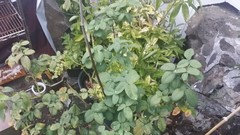
 this is Pink Peace ... probably going to prune down. Will remove lava rock and maybe repot after I repot Distant Drums, Secret, Good As Gold and Coretta Scott King (and probably the musk roses too, they are getting big)
this is Pink Peace ... probably going to prune down. Will remove lava rock and maybe repot after I repot Distant Drums, Secret, Good As Gold and Coretta Scott King (and probably the musk roses too, they are getting big)
 and here's Paul Neyron ... hasn't bloomed out since April I think
and here's Paul Neyron ... hasn't bloomed out since April I think
strawchicago z5
Original Author8 years agolast modified: 8 years agoFor the 2nd picture of Pink Peace, I see very dark-green foliage, plus purplish tinge on some leaves. That's typical of phosphorus deficiency, induced by high-nitrogen fertilizer. High nitrogen will zap out phosphorus, regardless of how much phosphorus supplied.
Symptoms:
Phosphorus deficiency is most often manifested as purpling of the leaves, particularly the leaf veins. In severe cases the whole plant may take on a purple hue." Another site quote "leaflets droop, curl backward and develop strong, dull purple tints."I see leaf-droop & leaf curl in Pink Peace. My mint plants look like that: I get purplish-coloring on the back-side of my mint-leaves, since I give it nitrogen fertilizer NPK 12-0-0 ... I don't want mint to bloom, I want leaves only.
For Paul Neyron picture, I see thin, weak stem, typical of calcium deficiency. When I had Paul Neyron, he bloomed when I gave it calcium via sulfur/gypsum plus alfalfa meal, or potting soil with gypsum. Both calcium and potassium are needed for blooming, Paul Neyron has a higher need for both since the bloom is big & many petals. He's a wimpy-root, so the fast-release form of calcium: soluble gypsum is best. The dolomitic lime is slower-release, the roots must be aggressive enough like Dr. Huey to secrete acid to use it, but I don't think Paul Neyron root can do that, and many own-roots HATE lime (turn pale) ... own-roots can utilize calcium best in gypsum.
I would stop all nitrogen fertilizer for both Pink Peace and Paul Neyron. I got the most blooms on my own-root Pink Peace when I gave it SOLUBLE sulfate of potash together with SOLUBLE GYPSUM: I sprinkle around the bush, and water with my alkaline tap. Here's my own-root Pink Peace, the repeat was very fast & many blooms, even in full-sun above 80 degree:

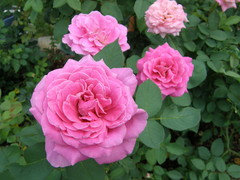
Here's own-root Pink Peace in a bouquet, note the many firm petals, thanks to potassium to induce blooming, and gypsum for fast-release of calcium:
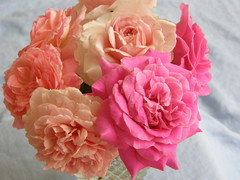
Here's my Pink Peace GRAFTED ON DR. HUEY, I put alfalfa pellets in the planting hole .. and ran out gypsum. The color is extremely gaudy, less petals, and didn't last long in the vase, thanks to deficiency in calcium:

jim1961 / Central Pennsylvania / Zone 6
8 years agolast modified: 8 years agoThe container size I used for Mister Lincoln and a couple other roses was this size. And I thought this size was to small for when the roses got larger...lol... I prefer to use huge pots to give the roots plenty of room to grow...
I bought a couple pots at our Dollar Store for $10 each that were larger than this one... Those I gave to my neighbor and he is growing giant tomato plants in them...

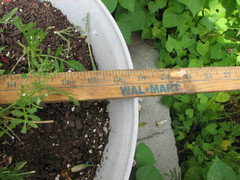
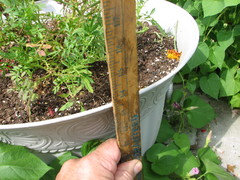
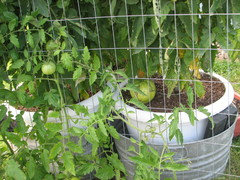

strawchicago z5
Original Author8 years agolast modified: 8 years agoThose are nice containers, Jim .. great deal you got $10 each. Are those tall plants tomato belonging to your neighbor?
Msgirl: It was sunny this morning when I looked at your pics. of Pink Peace, could not see clearly the color. Now it's night-time and I can see the color better, it's reddish shading on some leaves .. that's from red-lava-rock. I get a few reddish shading leaves on Stephen Big Purple, so I remove the red-lava rock. Less blooms after I removed it, but the shading didn't improve. I re-post the nutrients in red-lava-rock to see what's wrong:
http://www.palmercc.com/lavarock.htm
Nitrate Nitrogen.................................4.0 p.p.m.
Phosphorus........................................6.0 p.p.m.
Potassium.........................................59.0 p.p.m.
Zinc.........................................................6 p.p.m.
Iron..................................................10.0+ p.p.m.
Copper...............................................5.5+ p.p.m.
Magnesium.......................................2.0+ p.p.m.
Boron.................................................10.0 p.p.m.
Sulfate.................................................7.0 p.p.m.
Organic Material...........................................5%
PH.........................................................8.2 Units
Calcium..................................1.3 Meq/100 gm*Purplish shading is usually phosphorus-deficiency, which will happen with too much nitrogen, or too much potassium. My other roses didn't get the discoloration, but they came down with calcium deficiency, from too much potassium via red-lava-rock. I learn my lesson to use EQUAL amount of red-lava-rock and gypsum for own-roots, or red-lava-rock and dolomitic lime for grafted-on-Dr.Huey.
Red-lava rock is a cheap & slow-released form of potassium, but should be balanced with calcium & phosphorus for best blooming. My roses are less healthy after I removed the red-lava-rock, the anti-fungal agents boron, zinc and copper really help. I did put equal amount of red-lava-rock to gypsum in the planting holes of my new roses: Betty White, Bronze Star, and Tchaikosky .. so far big blooms on them all, after 1 month planting.
Below is my 3rd bloom of Tchaikosky, picture taken today August 8, it opened up to 4 inch. diameter, which would NOT happened had I kept that in potting soil. Last year I had 4 roses in big pots: Souv. Du President Lincoln, Madame Isaac Pereire, Carding Mill, and Heirloom ... Two gave really tiny blooms, and the other gave tons of leaves, but no blooms. I used MG-potting soil with slow-released fertilizer (equal nitrogen & equal phosphorus & potassium). Gardenguide.com gave a different ratio: "Fertilizers used on flowers should contain low levels of nitrogen relative to phosphorus and potassium. A 5-10-10 formula (5 percent nitrogen, 10 percent phosphorus, 10 percent potassium) is ideal. Calcium may be in short supply in acid soils."
Read more: What Nutrients Do Flowers Need to Survive? | Garden Guides

strawchicago z5
Original Author8 years agolast modified: 8 years agoGarden Guides site gives excellent info. on spotting nutrient-deficiency: "Potassium is useful in forming sugars, starches and carbohydrates that are essential in plant protein synthesis and cell division. It controls water intake and deficiency as well as making the plants tough and capable of enduring cold. When plants lack potassium, they appear speckled and blemished, with bent and charred leaves. Sulfur helps produce chlorophyll. Just like nitrogen, it comes from amino acids, proteins, vitamins and enzymes. Light-colored leaves appear when plants lack sulfur. Magnesium is another important component of the chlorophyll and aids in the way carbohydrates, sugars and fats function. Yellowing, droopy leaves are signs of magnesium-deficiency. Calcium is a component of the cell walls and helps manage the volume of water. It is vital for cell growth and division (mitosis). Calcium-deficient plants may show little or underdeveloped bloom production. Twisted new growth, black spotted leaves, pale or yellow leaf margins are also signs that the plant lacks calcium.
Read more: Nutrients for Blooming Plants | Garden GuidesMore info. on the nutrients needed for flowering:
http://homeguides.sfgate.com/nutrients-flowering-fruiting-plants-30026.html
"Boron aids in cell wall formation and calcium uptake, as well as flowering, pollen germination and fruiting. Iron is necessary for healthy development of all parts of young growing plants. Manganese enables respiration and nitrogen metabolism, and zinc is required for stem growth. Molybdenum and nickel are both needed for healthy seed formation and germination, and silicon improves stem strength."
I'm testing equal amount of red-lava-rock to pea-gravel in the planting hole, to see how healthy a rose is, and how much flowering it gives. Soluble fertilizer is expensive, and it's nice to do permanent fertilizing in the planting hole.
strawchicago z5
Original Author8 years agolast modified: 8 years agoMsGirl: This week I gave my roses SOLUBLE gypsum (from Alpha Chemicals bought on Amazon). I'm very pleased, it dissolved instantly when I hosed-in. The old garden roses like Duchess de Rohan (bred in France), and Comte de Chambord (bred in France) really love gypsum ... became very vigorous & more blooms. Paul Neyron was also bred in France. For such old garden roses, they really like gypsum (calcium sulfate).
When we had tons of rain early summer, Austin & Landscape roses had big blooms at Chicago Botanical Garden, but Old Garden Roses (bred in France) were very disappointing: blooms were 1/2 their normal size, due to rain leaches out calcium.
msdorkgirl
8 years agolast modified: 8 years agoHere is the Pink Peace that is having issues, I will be removing all bad looking leaves and trimming down, then will keep it under shade with new potting mix and no lava rock on the top:

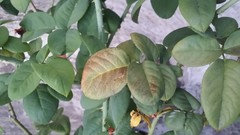
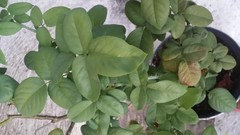
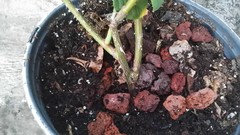
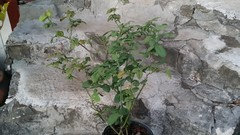
None of my other roses have leaves that look like that. This is the only else with lava rock on top ... hence me thinking It might be the cause.
I'll post this on the main rose forum too to get their opinions.strawchicago z5
Original Author8 years agolast modified: 8 years agoRed lava had just stained my cement patio .. I really think it's the high iron rather than potassium. My lawn-fertilizer has a much lower % of iron than red-lava-rock, and the label said to keep off cement, since the iron will stain the cement. One time I used molasses (high in iron) to fertilize Gina's rose (own-root) ... except it was too concentrated, Gina's leaves got even darker-brown stains. From that time on, I diluted the molasses much further.
I over-dosed on sulfate of potash before, NPK 0-0-50, and didn't have any staining problems. I have red-lava on all my roses until August, which I took them off due to the heat. Only Stephen big Purple has stained-leaves like your Pink Peace, some roses can't utilize iron, and the excess will stain leaves.
Also own-root-roses have wimpy roots CLOSER TO THE SURFACE, and will absorb fast the nutrients from above. That's different from GRAFTED-ON-DR.HUEY, with a long stick root, much further down. I put tons of cocoa mulch on top of GRAFTED-Pink-Peace, no problems whatsoever ... I buried Dr. Huey 4 inch below ground. But when I put cocoa mulch on wimpy-own-roots in pots, they broke out in rust immediately, due to the acid leaching down from the cocoa mulch.
Same with salty horse manure: no problems with the roses in the front, with much deeper roots. But the roses in the backyard, which I poked holes with a bamboo stick for better drainage, the manure's salt leached down fast, and I got salt-burn on their leaves.
strawchicago z5
Original Author8 years agolast modified: 8 years agoAzomite DOES NOT increase the calcium in plant. that's best done through fast-release gypsum (calcium sulfate). Here's an excerpt from below link: "Azomite: Researcher reported statistically significant increases in the tomato fruit for five trace elements concentrations. Those elements included copper, potassium, magnesium, sodium, and manganese."
prairie_northrose (3b north of Calgary AB, Canada)
8 years agoI was not able to easily get Azomite here, but I was happy to find Gaia Green Glacial rock dust which I am curious to try. http://www.gaiagreen.com/rockdust.html
The number of guaranteed minerals described is lower compared to Azomite.
strawchicago z5 thanked prairie_northrose (3b north of Calgary AB, Canada)strawchicago z5
Original Author8 years agoThank you, Prairie for info. on Glacial rock dust: Calcium (Ca) …………1.4%
Magnesium (Mg) 0.562%
Cobalt (CO) 0.00234%
Iron (Fe) .0.95%
Sodium (Na) 1.25%I checked on that and it looks like glacial rock-dust is similar to pea-gravel in geology, except finely ground. I like pea-gravel (small size), or river-pebble (bigger size) since they are slow-released and won't cause harm in hot weather like Azomite. Pea-gravel is sold for $2 for 40 lbs., I already tested that against Azomite in rain water for cut-blooms in the vase. Pea gravel gives off this beige powder immediately in rain-water, is a better buffer against rain. Below is a picture of pea-gravel:

strawchicago z5
Original Author7 years agolast modified: 7 years agoI put 4 pieces of red-lava-rock around each tomato plant .. I have 24 plants in the front which my garden-hose can't reach.
Below is a picture taken after 2 weeks of zero rain, zero watering. It's rock-hard clay, topped with leaves in late fall .. then I fixed my heavy clay with 2 cups gypsum, 1/2 bag of sand, 2 cups Tomato Tone NPK 3-4-6 when I planted these tiny tomatoes in Mid-May .. they were $2 per 6 pack of tiny plants.
Picture taken July 3, no wilting, lots of fruits, no pests, no worms, no need to stake either, stem is thick. I mulched with grass clippings, note the annual flowers look really bad, temp is around 85 F, full-sun, zero water for 2 weeks:

strawchicago z5
Original Author7 years agolast modified: 7 years agoRed lava rock, or red-lava-sand, is a great source of iron and potassium. pH of red-lava-rock is 8.2. Red-lava rock is OK like 3 or 4 pieces, too much will UP the soil pH, plus prevent water from soaking through. I went to my neighbor when it was above 90 F one summer. She mulched her roses with THICK layer of black lava rock. I touched them, and they are the same temp. as our rock-hard-clay. She overkilled on the lava-rock: too much potassium drove down nitrogen, so her roses didn't have much leaves, lots of blooms.
I would use no more than 3 pieces per rose .. too much and one gets iron-burnt (brown-spot).
http://forums.gardenweb.com/discussions/1539970/lava-rock-as-mulch
ocdgardener(8)
From what I understand about Lava Rocks is: Lava rock breaks down into Lava Sand. From all the sand in the bags I know it happens! Lava Sand is recommended as a soil amendment to HOLD MOISTURE. Now, the only thing I'm not sure about is temperature. I did notice though oddly enough last night when I got home from work the plants in the same bed mulched with cedar were wilting, the plants surrounded by lava were not.
Here's the positives I've found thus far.
On a slope where my bed is, compost, and every thing else added at the base of the plants washes down to the bottom and is replaced with bare soil. I have to add mulch over and over because it all slides away. The Lava Rocks are not only holding the compost in place but are keeping me from having bare soil. I know it does because we had a heavy rain this morning and I looked and everything was in place! --Not the usual bare soil I see after a rain!
I think I should explain how I'm using the rock. I'm taking one rock at a time and pressing it into the soil. When you think of lava rocks as a mulch I think most people tend to imagine it piled up. ocdgardener(8) oh and btw you can't really see that much of the rock anyway - because the plants cover them. Example: This is what the yard looks like in the spring.

ocdgardener(8)
Update on the lava rock! I bought a soil thermoter and tested the temps. Although not lower, the temps were pretty close to the same by a degree. Also, I have calendulas blooming in the bed in the HEAT of summer. I've never had that before!
Lava Rock has low thermal mass. It does not retain heat. Lava Rock keeps the soil soft like mulch, so if there is a weed, no problem, it pulls really easy. I prefer red lava rock, although I have both. Never put plastic underneath it! It keeps most weeds out as is.
I don't know what happened to my original post, but here is a short repeat. LAVA ROCKS ARE WONDERFUL PLANTERS, ESPECIALLY IN THE EXTREME HEAT OF THE MOHAVE DESERT. Yup. I build and use cedar planters and window boxes all over my home, they are great, but do not compare with the flowers grown in the lava rocks that I hollow out and plant a variety of species in. Plants in these rocks see temps to 120 degress in our summers and do just fine! They retain moisture, cool with the air temps, and fertilize plants naturally. I don't use lava rock for bedding, I can see the problems with that. But as a planter? The best planter I have ever had. AND, no maintenance, and years of use looking great.
Anyone who questions the ability of lava rock as a growing medium needs to come visit our islands out here in the Pacific. Our Hawaiian islands are completely volcanic is soil and sediment, covered in pure lava rock, and we have the most beautiful plants, trees, produce, and the like. Lava rock and volcanic soil is some of the most nutrient friendly planting medium on earth and is porous enough that it allows for good oxygenation and water flow. Come visit our islands and then come back and post how it's horrible to grow anything in volcanic rock or lava sand. Just my two cents : ) Aloooooha!
http://forums.gardenweb.com/discussions/1539970/lava-rock-as-mulch
strawchicago z5
Original Author7 years agolast modified: 7 years ago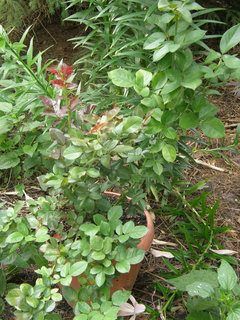
Above is 2-month old Poisedon bought from Rose-Unlimited as gallon-size own-root mid-May. Picture taken last week of June. It's very tall, but stingy, gave me only 2 blooms despite MG-potting soil & tomato tone NPK 3-4-6.
For the planting hole I buried 10 chunks of red-lava-rock and let rain water leached the potassium into the planting hole to make the soil fertile, in a span of 2 months. Prior to placing the root-ball into the planting hole, I took out all the lava-rocks .. I was concerned that the large rocks will hurt the tender own-roots. Within a week, Poisedon rose gave 7 buds, plus no wilting in hot sun like with acidic sulfate of potash (salt index of 42, and 21% sulfur). Will post a pic. of Poisedon loaded with buds later.
The above is the best way to make high potassium red-lava-rock dissolve into soil, but I would fish out the red-lava-rock for wimpy own-roots. WARNING: light-colored roses like Betty White petals become brownish-fringe with red-lava-rock, quite ugly. But dark-color roses, esp. red, really like the iron in red-lava-rock.
strawchicago z5
Original Author7 years agolast modified: 7 years ago
Above is a cheap lavender rose I got from Meijers last year, picture taken this July 4, 85 degree heat. It's on a steep hill, plus I buried Dr.Huey-rootstock 6 inch. below ground .. that's why it looks so short. I put red-lava-rock and pea-gravel inside the planting hole .. no blackspot, but there's holes in the leaves (from poor-drainage clay).
I don't recommend putting such rocks in the planting hole of wimpy own-roots, but Dr. Huey-rootstock is vigorous enough to handle rocks. That rose is very neglected, too far from my water-source . .. I figure out if I buried that rose so deep, it doesn't need watering. A neighbor also bought 6 of those Lavender roses ... but Dr.Huey took over, since he didn't bury them deep enough for winter survival.
strawchicago z5
Original Author7 years agolast modified: 7 years agoAzomite is sold $10 for 5 lb. on Amazon. The bag that I received from Amazon has: 0.2% soluble Potash, 1.8% calcium, 0.5% magnesium, 0.1% chlorine, 0.002% cobalt, and 0.1% sodium. The part that I don't like is the 0.1% chlorine and 0.1% salt. I'm dunking Pink Peace cut-blooms in 3 vases: 1) mint & rain water. 2) Azomite & rain water. 3) Red lava rock & rain water.
Result after 3 hours of soaking: Red-lava-rock gives the most perky bloom & leaves. Azomite ranked last, due to the high dose at 1 Tablespoon per 1 1/2 cup water, plus salt that's more concentrated in a vase. However, in a garden setting, the salt will be neutralized by calcium or organic matter in the soil.
Bluegirl in Texas gave me a great tip, she wrote: " I picked up a sack of Lava Sand from the local nursery--cost ~9 bucks, not too bad. It's a mix of sand & pebbles up to perhaps 1/3" big. I'm sifting out the bigger pebbles & sand & using the intermediate granules to add to the cutting media. Might be worth looking for up there if you're still finding the red lava rock useful--would save trouble busting it up."
Jay-Jay in the Netherlands use red-lava-dust in his medium to grow roses from seeds.
strawchicago z5
Original Author7 years agolast modified: 7 years ago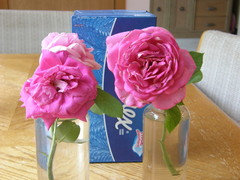
Above right picture shows Pink Peace dunked in 1 1/2 cups rain-water (pH 5.6) plus 1 teaspoon of Azomite give the best bloom after 3 days in the vase. Lots of petals too.
But the Pink Peace on the left opened too fast, and wilted in 3 days. It's pea-gravel soaked in rain-water, I submerged the leaves under the water, zero blackspots. Pea-gravel BEAT other vases with rain-water and additives such as lime, gypsum, mint-pureed, cracked corn, and Azomite in high dose of 1 Tablespoon per 1 1/2 cup made bloom wilted too soon. Azomite is best in tiny amount.
Azomite in low dose at 1 teaspoon per 1 1/2 cup rain-water produces the best result in bloom and perky leaves in hot temp. above 80 F, with acidic rain water (pH 5.6).
Below is a side-view of the vases, note how perky & firm the leaves are in Azomite vase, at 1 teaspoon per 1 1/2 cup water. To be safe, I would use 1 teaspoon per gallon of water as the web suggested. The dark-margins is from sun-scorch when I cut the bloom at 87 degree temp, full-sun. The wilted bloom is with pea-gravel/rain-water.
CONCLUSION: Azomite beat rock-dust (or pea-gravel dust) for both in-ground and in the vase. Azomite is a fine powder, so it works fast, but low-dose is best.
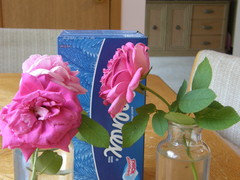
strawchicago z5
Original Author7 years agoApplication rate for 1 Quart of Micronized Azomite:
•Mix 2.5 tbsp. per 1 gallon of water per 40 sq. ft. and water lawn, garden, beds, trees and shrubs.
•When transplanting, use 1 tsp. per 2 inch plant diameter.Application rate for 1 quart Prilled Azomite:
•Prior to planting: sprinkle in bed (at 3 tsp. per 10 sq. ft.) and water.
•Vegetables and flowers: 2 tsp. per 10 sq. ft. add to hole when planting or sprinkle in garden bed then water.Here is a link that might be useful: Azomite and how to apply
strawchicago z5
Original Author7 years agoRe-post what I posted in July 2016 in another thread. Azomite dose at 2.5 tbsp. per 1 gallon is TOO HIGH and caused burn/wilting in hot weather.
strawchicago(zone 5a)

Red-lava-rock as SLOW-RELEASED beat mint-pureed and Azomite .. both are fast-released. From left to right, after 1 day of soaking in RAIN WATER (pH 5.6): Worst is mint pureed (I used 1/4 cup per 1 1/2 cup of water), leaves completely wilted. Next worst is Azomite (1 tablespoon per 1/2 cup of water) .. leaves are limp from too much Azomite (has 0.1 % salt).
Yes, I used too much Azomite !!! That should be 1 teaspoon per gallon of water .. just checked with the web.
Best is slow-released red-lava-rock, leaves are thick & perky ... firm petals. Azomite has 0.2% soluble Potash, 1.8% calcium, 0.5% magnesium, but with 0.1% chlorine and 0.1% sodium plus 0.002 % cobalt.
Azomite did great in-ground, due to leaching of salt from soil, but salt and chlorine can't leach from a vase, so the bloom soaked it up. Same with mint .. it did fine in-ground since my alkaline soil buffered its acidity, but acid alone in a vase can really wilt cut-blooms.
I saw Dee-lish (in a neutral potting soil) broke out in blackspot after 24 hours of rain, and it rained again, so I put 1 1/2 tablespoon of Azomite on top, then it rained for another day & night. Now looks good in 86 F, pic. taken July 8, after 2 days & 2 nights of constant rain & humidity. I also gave Dee-lish pea-gravel to raise the pH:
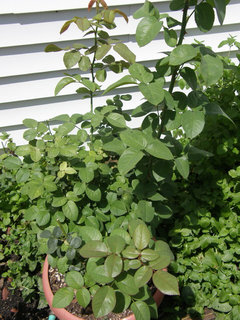
strawchicago z5
Original Author7 years agoMove info. about phosphorus and bone-meal here for reference.
strawchicago(zone 5a)
High nitrogen can hurt root and flowering ability in cotoneaster plant. See excerpt from below link:
http://www.sciencedirect.com/science/article/pii/0304423881900649
" Although root growth was not increased by either Nitrogen or Phosphorus, high N levels inhibited root growth."
More link to show that too much phosphorus can hurt root & flowering:
https://laidbackgardener.wordpress.com/2016/05/18/the-myth-of-starter-fertilizers/
"further studies showed that large quantities of phosphorous were not necessary for rooting. Yes, the soil must contain a small amount of phosphorus in order to stimulate rooting… but that’s also true of any other nutrient. If the soil totally lacks nitrogen, zinc or iron, that too will hamper rooting. In fact, plants actually root poorly in soils excessively rich in phosphorous. You’re far more likely to kill plant roots with 10-52-10 fertilizer than to stimulate their growth. "
http://davesgarden.com/guides/articles/view/3788/
" When plants are grown in low phosphorus environments they emit organic acids from their root tips. These acids allow mycorrhizal fungi to penetrate the roots and form the networks that assist roots in absorbing water and nutrients. If the phosphorus levels are too high the roots do not emit the acid and the mycorrhizal networks do not form. This forces the plant to put more effort into root growth to compensate for the lack of mycorrhizae."
U. of Colorado Extension has excellent info. on Organic fertilizers: "recent CSU research has shown that phosphorus from bone meal at NPK 3-15-0 is only available to plants in soils that have a pH below 7.0."
On rock phosphate: Recent CSU research results concluded that no rock P (regardless of mesh size) is available for plant use unless the soil pH is below 7.0.
http://www.ext.colostate.edu/mg/gardennotes/234.html
According to CSU, Kelp powder has NPK of 1-0-4, decent potassium, plus trace elements, only need 1/4 to 1/2 teaspoon per gallon, due to its high salt.
**** From Straw: I tested bone-meal many times, with negative result in my soil pH near 8.
1) killed over a dozen geraniums by topping with bone-meal in hot summer .. that burnt their roots, but their colors were vivid at first.
2) put bone-meal in the planting hole of Sharifa Asma, the color DID NOT deepen, but really wimpy root, plus the soil got hardened.
3) Killed a $30 gallica rose gifted by a friend with bone-meal in the planting hole.
4) Made Crimson glory really wimpy by putting bone meal in the planting hole.
5) Made wimpy Yves-pink-seedling into a Black-spot fest by moving it, then put bone-meal in the planting hole.
CONCLUSION: phosphorus is best in small amount as in 1/10 of potassium in rose-tissue analysis done by U. of CA at Davis. Phosphorus is best AS soluble, as in leaves, manure. Chicken manure at NPK 5-3-2 has plenty of phosphorus, plus trace elements zinc, copper, and boron.
strawchicago z5
Original Author4 years agoThe hard-minerals: pea-gravel and red-lava are BEST AT BOTTOM OF PLANTING HOLE, or at 1 foot below ground. If applied on top, these rocks HARDEN THE SOIL, and prevent rain from reaching down. My neighbor has Drift roses planted that way, they are 100% healthy for the past decade, in FLOODED area. It's always flooded with heavy around the Drift-rose bed. Rocks have high pH which neutralize acidic rain.





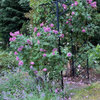
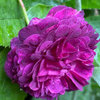
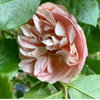
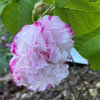
prairie_northrose (3b north of Calgary AB, Canada)